I. Introduction
Access to safe and sufficient water is essential to food security and nutrition. In recent years, water resources in many parts of the world have come under severe threat because of the depletion and degradation of habitats. Some of these threats are the direct result of a growing demand for food and the associated changes in dietary patterns.[1]
Globally, agriculture is by far the largest user of freshwater withdrawals, at an estimated 70 percent;[2] these withdrawals are almost entirely used for irrigation. In turn, providing 40 percent of the irrigation[3] is groundwater—a critical freshwater resource that can be extracted even during the dry season, unlike surface waters.
India is the world’s largest consumer of groundwater with more than 60 percent of the nation’s irrigation supply and around 85 percent of drinking water supplies provided by this resource.[4] Today, in many important agricultural regions across the country, groundwater reserves are fast getting depleted. Although the increase in cropping intensity has provided for food production gains, it has also resulted in high rates of extraction and, consequently, the depletion of aquifers. Estimates say that by 2025, the overall cropping intensity will reduce by up to 20 percent throughout the country and by almost 68 percent in the regions projected to have low future groundwater availability.[5] Compounding the challenge is climate change, whose impacts on rainfall patterns are an additional serious concern for improving agricultural productivity.
This paper examines the state of groundwater resources in the lower Indo-Gangetic plains of West Bengal, and the potential impacts of crop diversification on arresting the depletion of the scarce resource. The State of West Bengal accounts for the highest cropping intensity in India: an average farmer would utilise the total cultivable land 1.85 times or even more than 2.5 times in one agricultural year. The state is the largest source of rice (15 percent of the national total), a staple diet across most of India, and also the second-largest producer of potatoes (25 percent).[6] The growth in rice production has come primarily from Kharif rice, the high-yielding variety of which requires extensive use of irrigation, fertilisers, and insecticides.[7]
Irrigation in rice is applied five to six times more compared to other crops to facilitate land preparation and wet tillage in standing water before transplanting rice seedlings. The growing of Boro rice, and that of high-yielding vegetable crops, especially potato, has increased the groundwater requirements for irrigation. As a result, the groundwater table of West Bengal recedes by three to 12 metres or more during winter and pre-monsoon seasons. In the past decade alone, the expansion of farm land planted to Boro rice to the tune of five to 10 percent annually has contributed to groundwater pumping mostly from unconfined aquifers through private shallow tube wells. Many tube well systems have gone dry or are delivering pulsating discharges during the summer months, especially pre-monsoon.[8]
Between 1995 and 2004, water levels dropped by 16 to 70 cm in some blocks in several districts such as Murshidabad and Bardhaman. The drying up of tubewells and receding groundwater tables have led to a drinking-water crisis in these districts, coupled with arsenic contamination in the aquifers.[9] (Details of changes in water tables in WB districts in the last decade are given in Annex I.)
West Bengal therefore presents itself as an important case study for examining how alterations of farm production can benefit water use. Rice is the least efficient water user among cereals for the production of important nutrients.[10] With a guaranteed Minimum Support Price (MSP) to producers and huge subsidies on rice to the consumers, the cropping and dietary choices have discouraged the production of more nutrient-rich alternative cereals, which are also less water-intensive, contributing to widespread nutrient deficiencies.[11] Given the limited water resources and changing dietary preferences, sustainable food production requires improving water use efficiency and water productivity, while fulfilling people’s nutritional requirements. Linking yield, water use, and nutritional content can guide the adoption of cropping patterns that are less water-intensive and more nutritionally rich.
The present paper is an attempt to examine possible water savings by replacing high water-consuming Boro rice by the less water-demanding maize and barley cultivation in the lower Indo-Gangetic plains. The analysis covers the districts of Murshidabad, Birbhum, Bardhaman, Hooghly, and North24Parganas. The paper aims to examine whether improvements in freshwater availability and nutritional gains can be achieved together. It explores the potential improvement in availability of water resources when rice, wheat and potato, are replaced by alternative crops; and estimates nutritional productivity (nutrient unit/m−3 of water) of major and alternative crops (cereals plus potato) grown in the selected districts.
II. Methods and Data
Data
The authors collected production data for five major crops specific to five districts in the lower Gangetic plains of West Bengal, in the new and old alluvial zones of the state. The districts are: Murshidabad, Birbhum, Bardhaman, Hooghly, and North24Parganas; the crops are: Boro rice, Kharif rice, wheat, maize, barley, bajra, and potato. (See Table 1)
Rice is the most predominant crop in West Bengal. The three major varieties of rice found in the state are: Aus Rice (sown in summer and pre-monsoon, and harvested in autumn); Kharif or Aman rice (sown in the rainy season and harvested in winter); and Boro rice (sown in winter and harvested in summer). The highest rice production is of Kharif, followed by Boro and Aus.[a]
Table 1: Cropping Patterns of Selected Districts
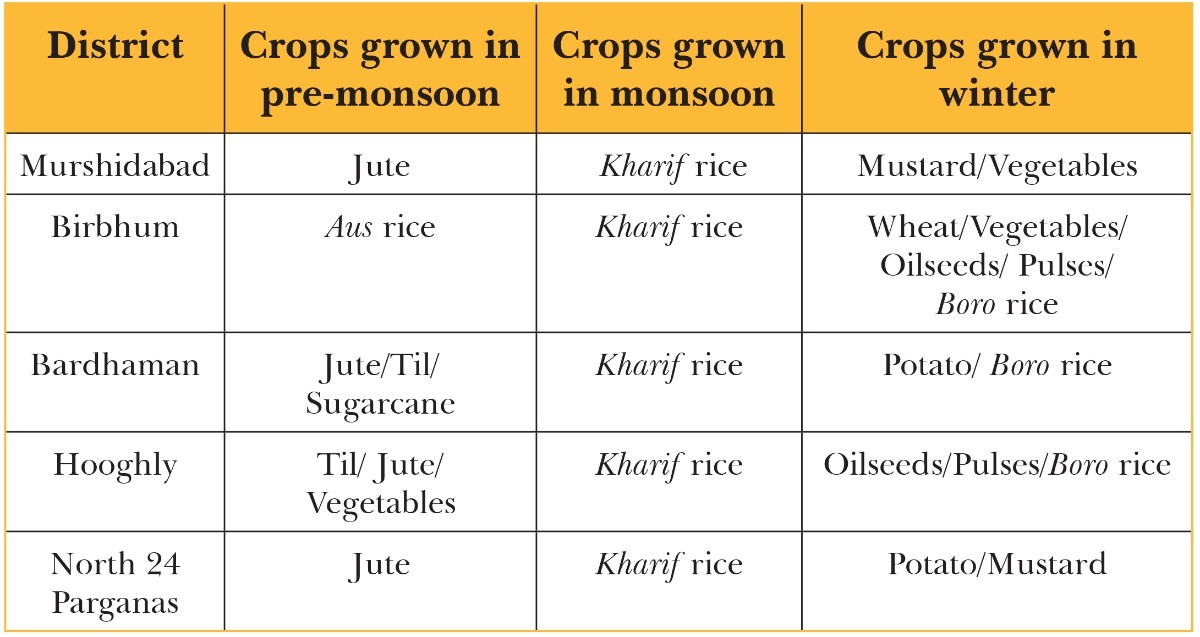
Source: Authors’ own
Methods
1. Water resources available for reallocation
The following indicator is evaluated for each cropping pattern: water resources available for reallocation (WR) given in mm over the cropping season. Water resources available for reallocation, is estimated as follows:

where is the estimated actual evapotranspiration[b] from rice field, and the estimated actual evapotranspiration for the maize field. the estimated actual evapotranspiration for the bajra/barley field. Similarly, is estimated for other crops like wheat, sorghum, and potatoes.
2. Nutritional water productivity (nutrient unit/ m−3of water)
Nutritional water productivity is a useful metric for quantifying the water-food-nutrition nexus. Increasing food production and productivity are getting increasingly tied to nutrient density.
Nutritional water productivity )[12] can be calculated based on the formula by Renault and Wallender (2000):[13]
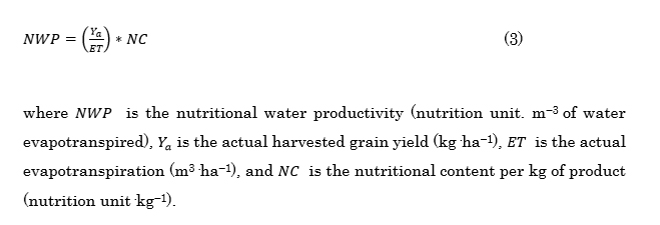
where is the nutritional water productivity (nutrition unit. m−3 of water evapotranspired), is the actual harvested grain yield (kg·ha−1), is the actual evapotranspiration (m3·ha−1), and is the nutritional content per kg of product (nutrition unit·kg−1).
III. Results and Analysis
Table 2 summarises the water requirements of various crops grown in the lower Indo-Gangetic plains of West Bengal.[c] Of all the crops, rice has the highest water requirement.
Table 2: Water Requirement of Crops, West Bengal

Source: Prasad (2016)[14]
While estimating water resources available for reallocating, the actual evapotranspiration rate is measured. Actual evapotranspiration is an important physical process in natural ecosystems. It is a crucial component of the hydrological cycle explaining the exchange of water and energy between the soil, land surface, and atmosphere. An improved characterisation of is especially important for the management of water resources and related ecosystem services, as well as in addressing global climate change. By affecting rates, climate change disrupts soil moisture, vegetation productivity, the carbon cycle, and water budgets.[d],[15]
The evapotranspiration rate is expressed in mm per unit time, which in the case of this study is per day rate, which is averaged out over the entire crop season. Estimates of actual evapotranspiration () given in Table 3 show actual evapotranspiration to be highest in rice, followed by jute—the two most important crops in West Bengal; maize and potato then follow. These rates vary across districts. The crop water requirement along with water loss is the highest for rice. Higher yields are associated with higher rates. The yield rates across crops cannot be compared because of the gap in time period in production data. This is particularly true for alternative crops whose production started only recently in certain parts of West Bengal compared to the traditional crops of rice and wheat. However, comparing crop yields and rates within districts gives some direction about the crops that can be grown in place of Boro rice.
Barley or Jau, scientifically known as Hordeum vulgare L, which is otherwise one of the most important cereal crops in the world after rice, wheat and maize, has lost its significance in West Bengal as a nutritionally dense crop.[e] The production of barley has nearly stopped since 2011-12. Today, barley is sparsely grown only in the districts of Jalpaiguri, Uttar Dinajpur, Maldah, Murshidabad, Birbhum, and Nadia. The from Barley fields is low.
Table 3: Actual (value in mm)
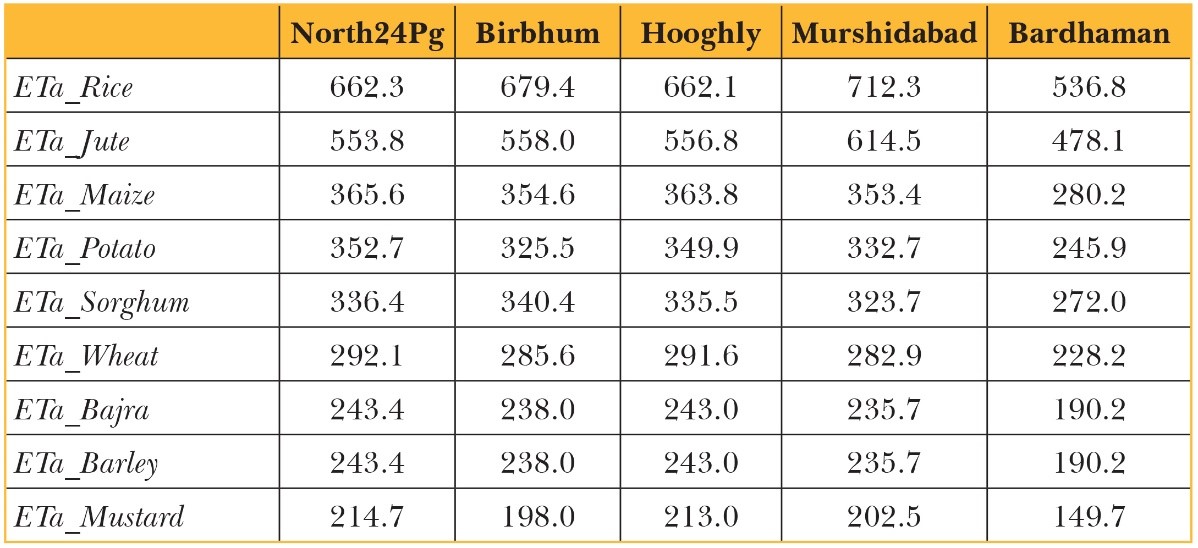
Source: Authors’ calculations
Table 4 gives a snapshot of crop yields across districts along with actual evapotranspiration rates. The determination of can be a viable tool to estimate the amount of water being taken up or used by fields and crops. Such information is useful to better calculate crop water requirements and guide water use efficiently while planning irrigation schemes.
Maize, one of the fastest growing cash crops, has higher yields—almost like rice or even higher. At the same time, it requires more water transpiration and therefore more evapotranspiration which is less than that of rice but higher than for wheat, barley, bajra, sorghum, potato, and mustard.[f]
Table 4: Actual and Yield of Selected Crops

Source: Authors’ calculations
Based on the actual evapotranspiration rates presented in Table 3, multiple district-level crop replacement options are presented in Table 5. Reduced evaporation losses (E) and crop transpiration (T) releases water resources for other uses. These options signify reduced consumptive water demand, in particular when replacing Boro rice with other crops.
Table 5: Water Resources Available for Reallocation (value in mm)

Source: Authors’ calculations
Shifts in crops will not only benefit the aim of conserving water, but also address the various forms of malnutrition. Measuring the nutritional content of agricultural production is crucial to transitioning to nutrition-sensitive agriculture. Subsequently, there has been a paradigm shift in current food production to consider nutritional outcomes—i.e., food production also considers nutritional gains or nutritional productivity, instead of only resource-use efficiency.
Of the crops grown in the lower Indo-Gangetic plains of West Bengal, rice and potato have the lowest macro and micronutrients (see Table 6). Maize has the highest phosphorous content and is nutritionally dense in macronutrients. Meanwhile, Barley has the highest fibre content, and Bajra is rich in micronutrients. The alternative cereals have higher content of nutrients like protein, fibre, calcium, and iron.
Table 6: Nutrient Content (per kg product)

Source: C. Gopalan, B.V. Rama Sastri and S Balasubramanian[16]
Using the measure of nutrient content in per kg of output against the nutrient unit in m−3 of water, these authors examined the water footprint (WFP) of different cereals for the production of key nutrients. Rice is the most inefficient water user among other rabi crops. (See Table 7) A comparison across districts shows that higher yields in maize are associated with higher water productivity (WP).
Based on the lowest WFP or the highest WP, maize stands out for its better yield and water productivity compared to rice, although there are variations across districts. Meanwhile, barley—grown in only two out of the five selected districts—has low yields and water productivity. Indeed, the WFP of barley is almost similar to that of rice, but unlike rice which has a very high crop water loss, barley has low crop water loss. Barley yields are low, which can explain its high WFP even though its water requirement is less relative to that of rice. Production per hectare of land and m−3 of water are also low. Rice, as expected—with larger area under production, its water requirements, and large volumes of production—has high WFP.
Table 7: Yield and Water Productivity (Average Values)

Source: Authors’ calculations
Tables 8 and 9 summarise the nutritional contents unit per m3 of water; Table 8 gives the energy or calorie (kcal. m-3) productivity for the selected crops.
Performing replacements based on nutrient water productivity, it is notable that despite potato having the lowest calorie content, it has the highest NWP (calories). Maize, meanwhile, with calorie content almost as much as that of rice and wheat, has the second highest NWP (calories). Barley, with little less calorie content than rice, has better NWP (calorie) compared to rice.
Primarily because of the way NWP is estimated, potato is found to have high yields and low water requirement, and therefore ranks best in NWP despite its poor nutritional content.
Table 8: Nutritional Water Productivity (NWP) for Selected Crops: Energy unit. m−3 of water (Unit: kcal. m-3)

Source: Authors’ calculations
Table 9 gives the estimated protein productivity of the selected crops. It ranges from 29.6 g. m-3 for Kharif rice to 202.2 g. m-3 for potato. Potato again appears to be the most productive source of protein; maize comes next.
Table 9: Nutritional Water Productivity (NWP) for Selected Crops: Protein unit. m−3 of water (Unit: g. m-3)
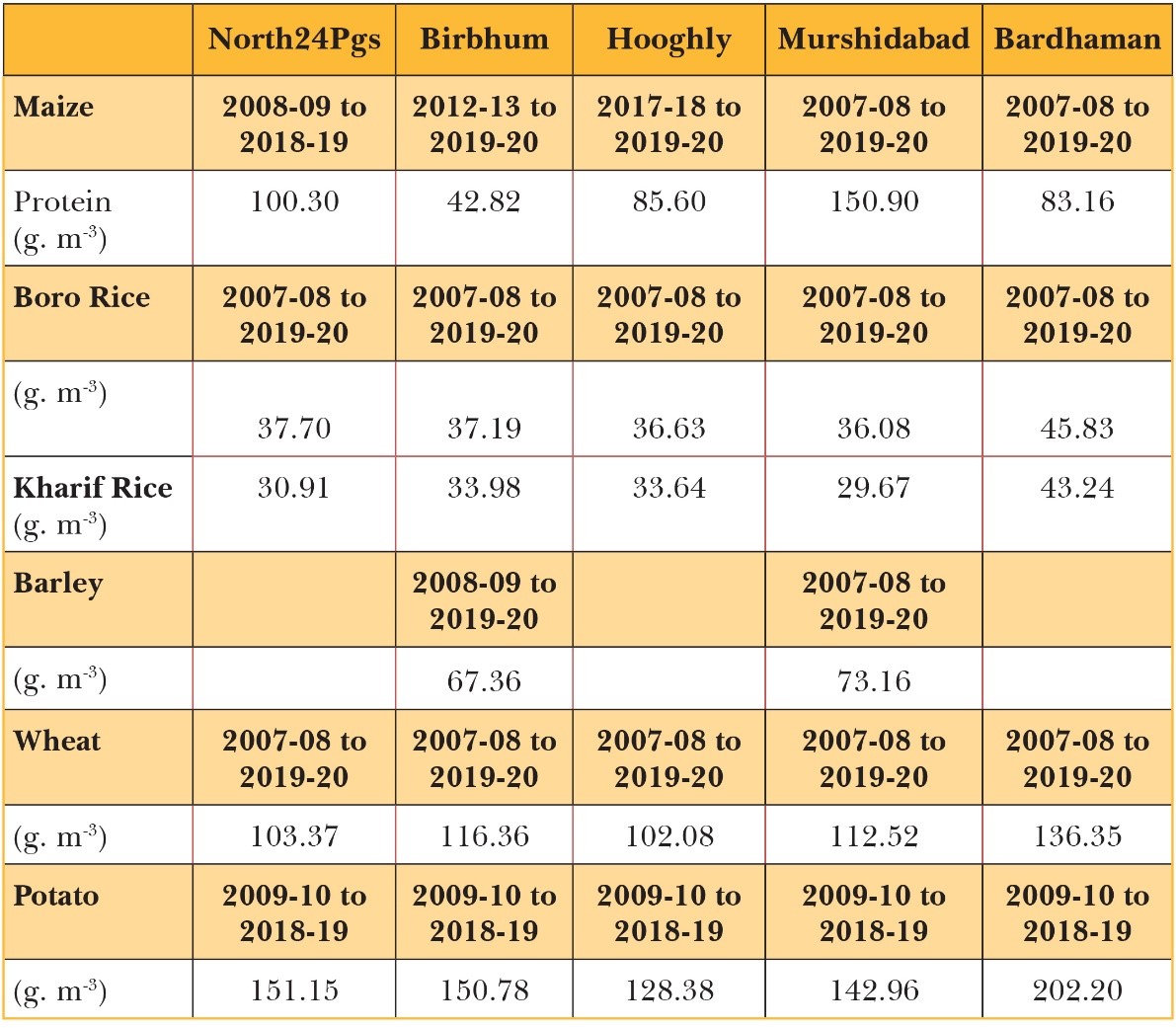
Source: Authors’ calculations
Based on nutritional output per m3 of water for calcium, bajra can be an alternative crop to Boro rice; maize can be a second choice (see Table 10). The advantage with maize is its high yield, low , and high . Potato, with even higher yields than maize and lower than maize, stands out for its high NWP despite low nutrients per kg product in almost all the cases.
Table 10: Nutritional Water Productivity (NWP) for Selected Crops: Calcium unit. m−3 of water (Unit: mg. m-3)

Source: Authors’ calculations
Table 11 gives the estimated iron water productivity of the selected crops. The NWP of wheat in terms of iron content is much higher than that of rice and maize: wheat not only has high levels of iron in every kg of product, it also has the best iron content per m3 of water (.
Table 11: Nutritional Water Productivity (NWP) for Selected Crops: Iron unit. m−3 of water (Unit: mg. m-3)

Source: Authors’ calculations
Finally, Tables 12 and 13 present Boro rice replacement scenarios. Because of unavailability of data in some districts, only three of the five districts can be compared when maize replaces Boro rice, and two districts for barley as an alternative. Replacing Boro rice with maize reduces irrigation water demand and improves the production of nutrients. Meanwhile, barley does not show promising results in terms of water reduction, but does have potential for improving the production of nutrients other than iron.
Table 12: Boro Rice Replacement Scenarios (Average Percentage Values): Maize Over Boro Rice

Source: Authors’ calculations
Table 13: Boro Rice Replacement Scenarios (Average Percentage Values): Barley Over Boro Rice
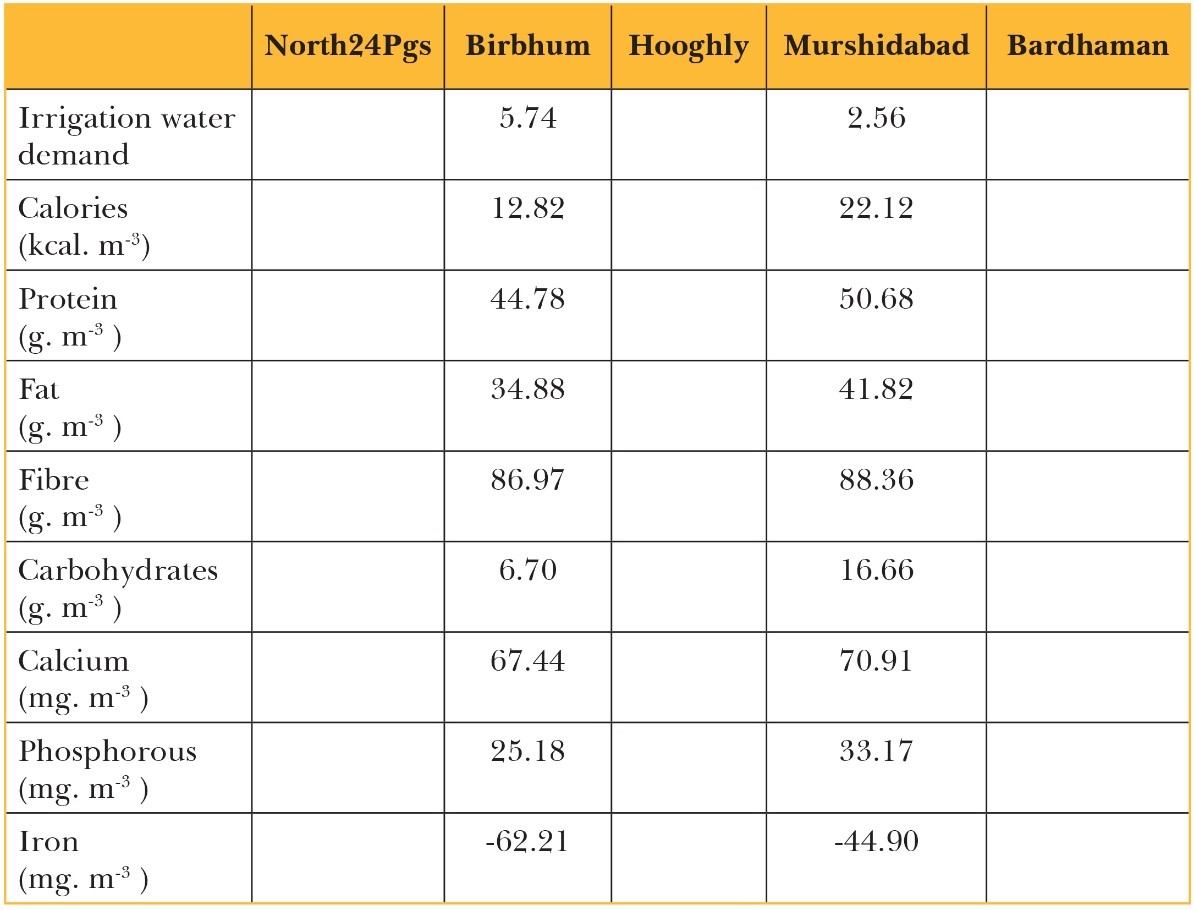
Source: Authors’ calculations
Discussion
The results of this analysis suggest that the best way forward for West Bengal is to adopt selective and district-specific strategies in promoting the farming of alternative cereals other than rice and potato. A substantial increase in the growing of rice and potato, both of which depend heavily on irrigation, has contributed to the reduction of groundwater levels in the selected districts of the lower Indo-Gangetic plains.
Estimating the evapotranspiration rates is important to assess water loss while growing crops. In the agricultural sector, evapotranspiration is an important soil-water balance component that plays a role in determining potential yields.[17] Evapotranspiration rates can be used to estimate the volume of water needed for growing crops. Farming decisions concerning cropping patterns can also be based on evapotranspiration rates where relatively lower rates suggest water resources can be made available by switching from one crop to another.
Among the crops considered, maize, which is nutritionally rich in micro and macronutrients, is found to have the highest yield potential compared to other cereals. The nutritional productivity of maize is higher than that of Boro rice in most cases. Maize is an important component of poultry feed and is also used in food processing and making biofuels.[18] Maize cultivation is fast growing, with rising yields in West Bengal. Farmers are choosing maize over rice since water consumption in rice is quite high.[19] Moreover, groundwater tables can be improved if maize cultivation is promoted in place of rice as it requires just one-fifth of the total water required to grow rice and also gives higher returns to farmers.[20]
The Central government has announced minimum support price (MSP) for maize. However, assuring farmers fair and remunerative prices to make maize cultivation more attractive needs public-private partnerships. The growth in MSP from INR 880/quintal in 2010-11 to INR 1,310/quintal in 2013-14[21] and INR 1,760/quintal in 2020[22] – has played a key role in increasing acreages by providing higher profits for maize cultivation. However, given the land constraints for other crops, maize acreages remain low relative to the crop’s potential. Maize usage in public distribution systems (PDS) remains limited, resulting in the price of maize settling at a lower rate than the MSP. There is also a shortage in farm-level infrastructure and storage infrastructure (by both the Food Corporation of India and West Bengal’s state warehousing corporation)—this becomes a challenge for maintaining quality for the end user. Moreover, large parts of the value chain of maize across India are low in quality compared to large global producers. These are some serious challenges that need focused policy attention.[23]
Another crop that has the potential to be grown in West Bengal is barley. It is salt-resistant and can be grown in sandy to moderately heavy loam soils; this makes the soil of the Indo-Gangetic plains, as well as the coastal areas of Sundarbans in West Bengal, most suitable for barley cultivation.[24] Barley can be grown under irrigated, rain-fed and limited irrigation conditions and requires less irrigation than rice. Barley is also used for animal feed, malt products, and human food. It is a competing crop for wheat and forms a part of nutritional security because of its growing demand for malt barley. The malt barley requires three irrigations to ensure better yield; however, the cultivation of barley requires quality seed for better production that can meet industrial uses. The MSP for barley (2020-21) grown in rabi season was around INR 1,525/ quintal. Though the MSP has been increasing every year since 2013-14, it is still less than that of wheat (INR 1,925).[25]
Declining acreage because of land constraints, along with poor market facilities, have restricted the cultivation of this crop. Indeed, most farmers, and not only in West Bengal, continue to grow old varieties of barley because of unavailability of latest varieties of seeds and technologies. With the increasing domestic demand for malting, there is a huge scope for farmers to make the cultivation of barley remunerative by adopting better cultivars with superior malting quality. [26]
This study has demonstrated that nutrition and environmental outcomes can be achieved through crop diversification that reduces water use in irrigated systems, like the rice-potato system in the Indo-Gangetic plains of West Bengal. To be sure, however, there are other considerations beyond water use, land use, and nutrient production that will determine crop choices. These include cost of cultivation, access to climate-resilient varieties, quality seed availability, assured market and price, area expansion, capacity building, storage and transport costs, and labour requirements. Further in-depth research on such aspects is needed to achieve the twin objectives of nutritional security and natural resource conservation.
IV. Conclusion
This paper seeks to contribute to the current discourse on agricultural productivity, which has moved away from the question of productivity per hectare of land to that of per cubic meter of water consumed. This shift in focus is relevant in the context of the impacts of climate change on agriculture, where the spatial and temporal changes in the rate of evaporation accompanying climate change are leading to variation in water availability and groundwater recharge. These have implications for crop growth. Moreover, rising populations and competing demands for water in other sectors, necessitates a rethinking of the sustainability of traditional crop choices.
In the state of West Bengal, Boro rice and potato are the most important rabi crops, both of which have high irrigation requirement. This study shows that replacing Boro rice with cereals like maize and barley can offer benefits in terms of reducing freshwater use and achieving nutritional gains. However, yield stability is key to ensuring continuous nutritional gain. While groundwater has helped West Bengal achieve grain self-sufficiency, aquifers are getting overexploited with implications for future crop production. There is a need to conduct further research that will explore the effects of farm management practices that are water-saving, as well as the climate and edaphic factors that influence nutrient content and nutritional water productivity.
Annex I
Table A1: Change in groundwater levels, by district 10 years mean (January 2011-January 2020)
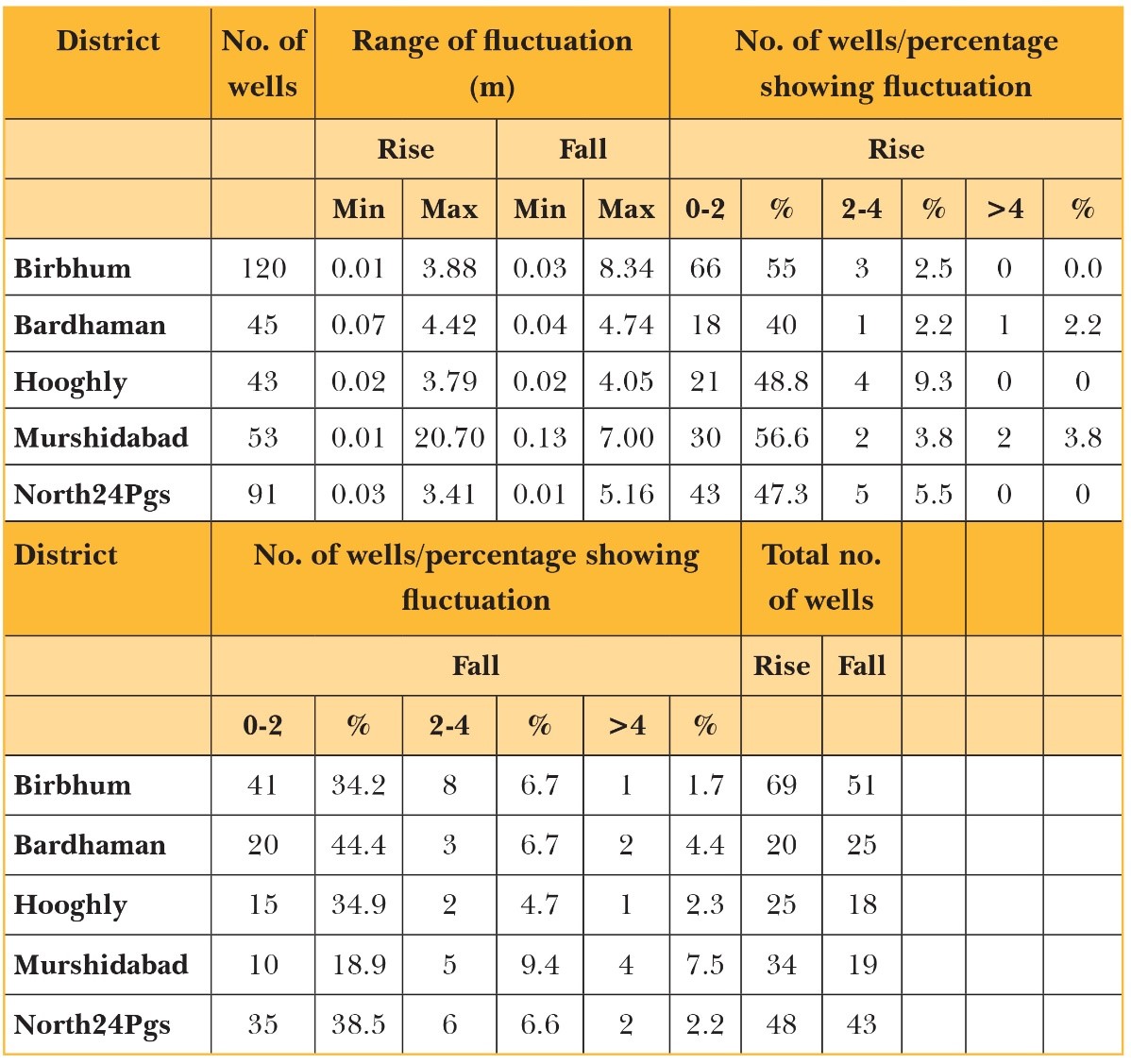
Source: http://www.indiaenvironmentportal.org.in/files/file/groundwater%20yearbook%20of%20west%20bengal%202020.pdf
Annex II
Calculation of Crop ET:
The actual crop from the field of different crops under study was worked out using following equation:

In the above equation, several parameters (like atmospheric pressure, latent heat of vaporization, psychrometric constant, etc.) were derived from other known parameters as recommended in UF/IFAS Extension.[29] The weather data of selected locations were collected from IMD through Agromet Advisory Service Project operating at Directorate of Research, BCKV, Kalyani.
Endnotes
The views expressed above belong to the author(s). ORF research and analyses now available on Telegram! Click here to access our curated content — blogs, longforms and interviews.

 PDF Download
PDF Download




















 PREV
PREV



